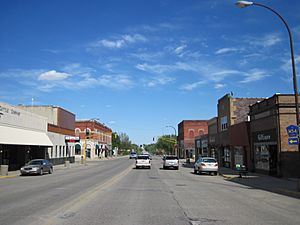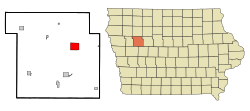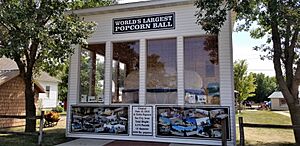Sac City, Iowa facts for kids
Quick facts for kids
Sac City, Iowa
|
|
|---|---|
 |
|
| Nickname(s):
"Home of Good Indians"
|
|
| Motto(s):
"Where Spirit Flows and Opportunity Grows"
|
|

Location of Sac City, Iowa
|
|
| Country | |
| State | |
| County | Sac |
| Area | |
| • Total | 4.96 sq mi (12.86 km2) |
| • Land | 4.90 sq mi (12.68 km2) |
| • Water | 0.07 sq mi (0.17 km2) |
| Elevation | 1,217 ft (371 m) |
| Population
(2020)
|
|
| • Total | 2,063 |
| • Density | 421.36/sq mi (162.67/km2) |
| Time zone | UTC-6 (Central (CST)) |
| • Summer (DST) | UTC-5 (CDT) |
| ZIP code |
50583
|
| Area code(s) | 712 |
| FIPS code | 19-69645 |
| GNIS feature ID | 0460882 |
Sac City is a city in Sac County, Iowa, United States. It is the main city and the county seat of Sac County. The city is located near the North Raccoon River. It is also one of 45 "Main Street Iowa" communities. These communities work to improve their downtown areas. In 2020, about 2,063 people lived in Sac City.
Contents
History of Sac City
Sac City was first planned out in 1855 by Joshua Keith Powell. The city got its name because the Sac and Meskwaki Native American tribes lived on the land when the Louisiana Purchase happened. Sac City officially became a city in 1874.
Early Settlers and Growth
Judge Eugene Criss is often called the "father of Sac City." He traveled from Wisconsin in 1855 in a covered wagon. He was looking for a good place to build a settlement. He chose the North Raccoon River area. Judge Criss built the first log cabin in Sac City. He also started a hotel and a general store for other settlers.
The Railroad Arrives
People started talking about building a railroad through Sac County in 1859. However, the first railroad did not arrive until 1879. Railroad companies only built tracks in areas that were already developed. They wanted to make money quickly. When the railroad finally came, it helped Sac City a lot. The Chicago and North Western Transportation Company connected Sac City to other towns. This made it easier to sell crops and travel.
Community Events and Landmarks
The first Sac County Fair was held in 1871. It took place on 10 acres (40,000 m2) of land east of Sac City. The fair was a very big event. People came from all over to see harness races, farm animals, and handmade items.
In 1904, the Sac City Chautauqua Association was formed. Chautauqua was a popular adult education movement. It brought many interesting programs to the community. Families would often camp out for the entire eight or nine-day session. At first, meetings were in a tent. By 1908, citizens built a special Chautauqua Building. This building is now the only one of its kind left in Iowa.
Modern Improvements
In May 2017, a local businessman named John Criss gave $5.7 million to the city. This money was for projects to make the city more beautiful.
Geography and Climate
Sac City is located at 42.421154 degrees north and -94.995083 degrees west.
The city covers about 4.93 square miles (12.77 square kilometers). Most of this area is land, with a small part being water.
Sac City's Climate
Sac City has a humid continental climate. This means there are big differences in temperature between seasons. Summers are warm to hot and often humid. Winters are cold, sometimes very cold. Rain and snow fall fairly evenly throughout the year. The climate type is known as "Dfa" (Hot Summer Continental Climate).
| Climate data for Sac City, Iowa, 1991–2020 normals, extremes 1893–present | |||||||||||||
|---|---|---|---|---|---|---|---|---|---|---|---|---|---|
| Month | Jan | Feb | Mar | Apr | May | Jun | Jul | Aug | Sep | Oct | Nov | Dec | Year |
| Record high °F (°C) | 68 (20) |
70 (21) |
88 (31) |
96 (36) |
108 (42) |
107 (42) |
113 (45) |
114 (46) |
103 (39) |
95 (35) |
80 (27) |
69 (21) |
114 (46) |
| Mean maximum °F (°C) | 47.6 (8.7) |
53.5 (11.9) |
70.7 (21.5) |
82.2 (27.9) |
88.7 (31.5) |
92.0 (33.3) |
93.0 (33.9) |
91.5 (33.1) |
89.3 (31.8) |
83.8 (28.8) |
67.9 (19.9) |
52.9 (11.6) |
94.4 (34.7) |
| Mean daily maximum °F (°C) | 26.4 (−3.1) |
31.1 (−0.5) |
44.4 (6.9) |
58.9 (14.9) |
70.1 (21.2) |
80.1 (26.7) |
83.2 (28.4) |
80.9 (27.2) |
75.2 (24.0) |
61.8 (16.6) |
45.1 (7.3) |
31.7 (−0.2) |
57.4 (14.1) |
| Daily mean °F (°C) | 17.1 (−8.3) |
21.5 (−5.8) |
34.0 (1.1) |
46.7 (8.2) |
58.5 (14.7) |
69.0 (20.6) |
72.5 (22.5) |
69.9 (21.1) |
62.4 (16.9) |
49.5 (9.7) |
34.7 (1.5) |
22.9 (−5.1) |
46.6 (8.1) |
| Mean daily minimum °F (°C) | 7.8 (−13.4) |
11.8 (−11.2) |
23.5 (−4.7) |
34.5 (1.4) |
46.9 (8.3) |
57.8 (14.3) |
61.7 (16.5) |
58.9 (14.9) |
49.7 (9.8) |
37.2 (2.9) |
24.4 (−4.2) |
14.0 (−10.0) |
35.7 (2.1) |
| Mean minimum °F (°C) | −14.0 (−25.6) |
−8.9 (−22.7) |
2.8 (−16.2) |
21.2 (−6.0) |
33.6 (0.9) |
45.7 (7.6) |
51.6 (10.9) |
49.9 (9.9) |
35.3 (1.8) |
21.9 (−5.6) |
8.1 (−13.3) |
−7.1 (−21.7) |
−17.4 (−27.4) |
| Record low °F (°C) | −35 (−37) |
−30 (−34) |
−19 (−28) |
4 (−16) |
23 (−5) |
32 (0) |
42 (6) |
35 (2) |
21 (−6) |
−2 (−19) |
−11 (−24) |
−28 (−33) |
−35 (−37) |
| Average precipitation inches (mm) | 0.73 (19) |
0.96 (24) |
1.82 (46) |
3.48 (88) |
4.59 (117) |
5.14 (131) |
3.89 (99) |
4.43 (113) |
2.89 (73) |
2.42 (61) |
1.57 (40) |
1.17 (30) |
33.09 (841) |
| Average snowfall inches (cm) | 7.0 (18) |
7.4 (19) |
4.2 (11) |
1.9 (4.8) |
0.0 (0.0) |
0.0 (0.0) |
0.0 (0.0) |
0.0 (0.0) |
0.0 (0.0) |
0.5 (1.3) |
2.7 (6.9) |
7.2 (18) |
30.9 (79) |
| Average precipitation days (≥ 0.01 in) | 4.9 | 5.4 | 7.4 | 9.9 | 12.6 | 11.3 | 8.9 | 9.3 | 8.5 | 8.3 | 5.2 | 5.5 | 97.2 |
| Average snowy days (≥ 0.1 in) | 3.6 | 3.6 | 2.0 | 0.9 | 0.0 | 0.0 | 0.0 | 0.0 | 0.0 | 0.3 | 1.2 | 3.8 | 15.4 |
| Source 1: NOAA | |||||||||||||
| Source 2: National Weather Service | |||||||||||||
People of Sac City
| Historical population | |||
|---|---|---|---|
| Census | Pop. | %± | |
| 1870 | 156 | — | |
| 1880 | 595 | 281.4% | |
| 1890 | 1,249 | 109.9% | |
| 1900 | 2,079 | 66.5% | |
| 1910 | 2,201 | 5.9% | |
| 1920 | 2,630 | 19.5% | |
| 1930 | 2,854 | 8.5% | |
| 1940 | 3,165 | 10.9% | |
| 1950 | 3,170 | 0.2% | |
| 1960 | 3,354 | 5.8% | |
| 1970 | 3,268 | −2.6% | |
| 1980 | 3,000 | −8.2% | |
| 1990 | 2,492 | −16.9% | |
| 2000 | 2,368 | −5.0% | |
| 2010 | 2,220 | −6.2% | |
| 2020 | 2,063 | −7.1% | |
| U.S. Decennial Census | |||
In 2020, Sac City had 2,063 residents. There were 953 households, which are groups of people living together. The city's population density was about 421 people per square mile (162.7 per km2).
Most residents (95.4%) were White. A small number of people were from other racial backgrounds. About 2.8% of the population was Hispanic or Latino.
The average age in Sac City was 46.6 years. About 21.5% of residents were under 20 years old. Also, 26.2% were 65 years or older. The population was slightly more female (52.9%) than male (47.1%).
Arts and Culture
Sac City Public Library
The Sac City Public Library has over 20,000 books, magazines, and films. It also offers educational videos and computers for public use. The library has special areas for children and adults. There are also rooms for studying alone or in groups. You can even get books from other libraries in Iowa through the Iowa Library Network.
Important Landmarks
Sac City has several interesting landmarks:
- Sac County Courthouse - This building is listed on the National Register of Historic Places.
- Sac City Monument Square Historic District - This area features a monument honoring soldiers from the Union Army.
- World’s largest popcorn ball - This giant popcorn ball is next to the Sac City Museum.
The World's Largest Popcorn Ball
Sac City is famous for its giant popcorn ball! The first one weighed 3,100 pounds. A new one was made in 2009, weighing 5,060 pounds. On June 18, 2016, volunteers built an even bigger one. It weighed an amazing 9,370 pounds! This huge popcorn ball is now on display in a special building. It is a fun roadside attraction for visitors.
City Services
Transportation
Sac City Municipal Airport
The Sac City Municipal Airport (KSKI) is about 2.5 miles (4 km) south of the city center. You can reach it using U.S. Routes 20 and 71. The airport covers 136 acres (0.55 km2) and is owned by Sac City. It is 1,250 feet (381 meters) above sea level.
The airport has a main concrete runway that is 4,100 feet (1,250 meters) long and 75 feet (23 meters) wide. There is also a secondary blacktop runway.
Education
Students in Sac City attend schools in the East Sac County Community School District. This district was formed in 2011 when the Sac Community School District merged.
Notable People
Many interesting people have come from Sac City, including:
- Earl Dew, a jockey
- George B. Perkins, a businessman and Iowa politician
- Doug Shull, a former Iowa State legislator
- Scott Stanzel, a former White House Deputy Press Secretary
- Samuel A. Stouffer, a social scientist
- Eric Swalwell, a member of the United States House of Representatives from California
- Paul Zahniser, a baseball player
See also
 In Spanish: Sac City (Iowa) para niños
In Spanish: Sac City (Iowa) para niños


